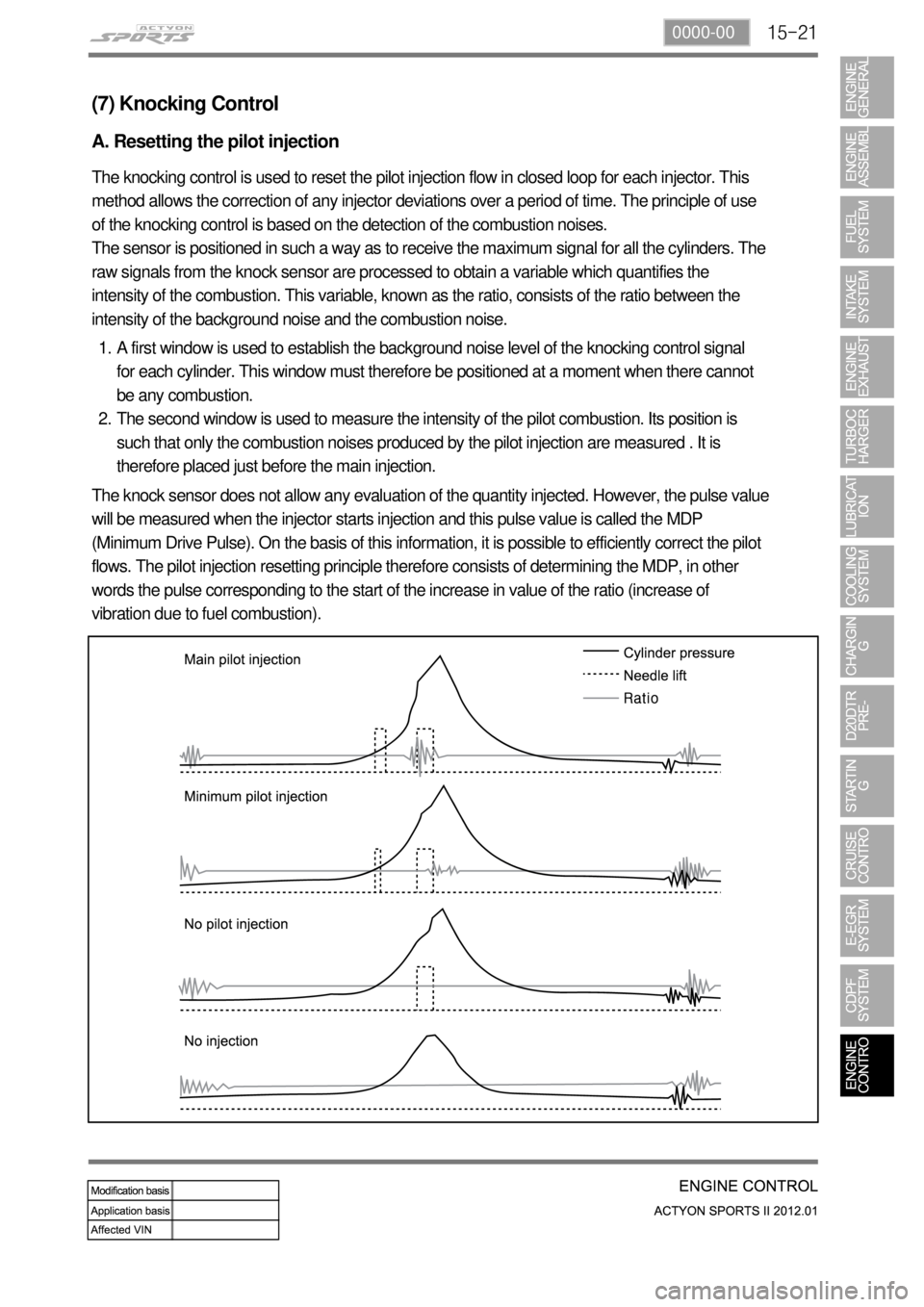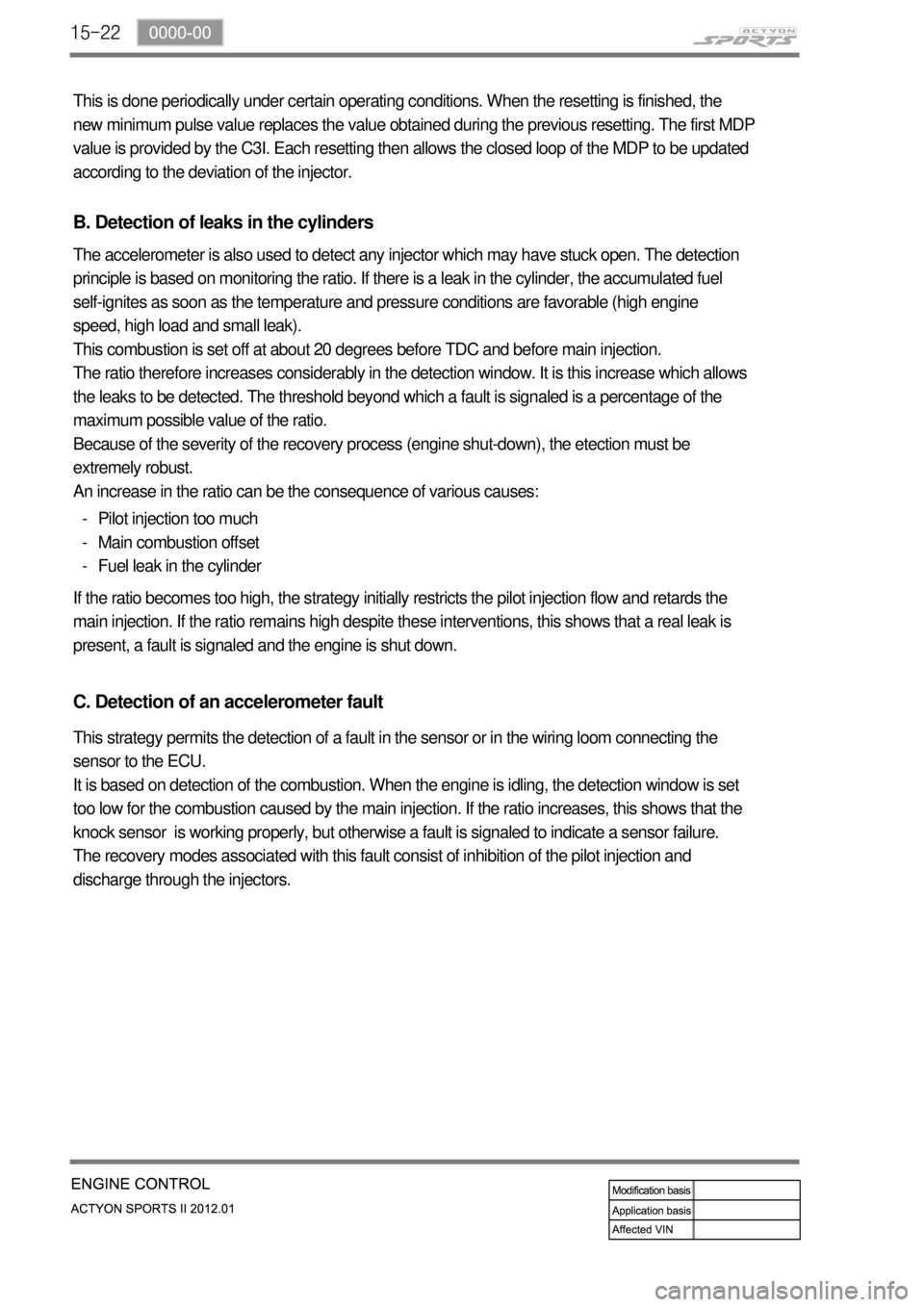window SSANGYONG NEW ACTYON SPORTS 2012 Service Manual
[x] Cancel search | Manufacturer: SSANGYONG, Model Year: 2012, Model line: NEW ACTYON SPORTS, Model: SSANGYONG NEW ACTYON SPORTS 2012Pages: 828, PDF Size: 91.28 MB
Page 27 of 828

1)
2) SB2~SB4, SB7~SB11, Ef3, POWER WINDOW RELAY SB5, SB6, Ef4, Ef5, Ef11, EF16, EF17, HORN RELAY, HEAD LAMP RELAY (LO)
Page 38 of 828

3
4
5
8
11
1461-00/2820-00/1491-00/8210-00/3110-00/3410-00/4892-00/8810-00/8010-00/7410-100/8510-00/8710-00/8510-00/8610-00/
8730-00/7340-00/7632-00/8310-00/8610-00/8510-00/8320-00/8410-00/8210-00/8310-00/4810-00/7770-00/8910-00/8790-00/6810-00
ENGINE1461-00 STARTING / CHARGING.................
1413-00 GLOW CONTROL UNIT...................
1491-00 ECU (ENGINE CONTROL
UNIT - D20DTR EU-V).....................
1490-00 ECU (ENGINE CONTROL
UNIT - GSL G23)............................
8210-00 DIAGNOSIS CIRCUIT.....................CHASSIS3110-00 TCU (6-A/T)...................................
3410-00 TCCU............................................
4892-00 ABS/ESP........................................8730-00 IMMOBILIZER CIRCUIT................
7340-00 SUNROOF CIRCUIT.......................
7632-00 CIGAR LIGHTER / POWER
OUTLET CIRCUIT........................
8310-00 HEAD LAMP CIRCUIT..................
8610-00 DRL (DAY TIME RUNNING
LIGHT) UNIT CIRCUIT.................
8510-00 HLLD (HEAD LAMP LEVEL G
DEVICE) CIRCUIT.........................
8320-00 TAIL LAMP CIRCUIT....................
8410-00 TURN SIGNAL / HAZARD
LAMP CIRCUIT.............................
8210-00 TRAILER LAMP CIRCUIT.............
8310-00 FOG LAMP CIRCUIT.....................
4810-00 STOP / BACK-UP
LAMP CIRCUIT.............................
7770-00 INTERIOR LAMP CIRCUIT............
7770-00 AUTO DIMMING ROOM
MIRROR CIRCUT.........................
8910-00 AUDIO / CLOCK CIRCUIT..............
8790-00 PARKING AID CIRCUIT..................
6810-00 PTC HEATER (POSITIVE
TEMPERATURE COEFFICIENT).....
6810-00 FATC (FULL AUTO TEMP.
CONTROL) CIRCUIT....................
6810-00 AIR-CON (MANUAL) CIRCUIT......... 12
14
1533
34
35
36
37
38
39
40
41
42
43
44
45
46
47
48
49
52
'
ELECTRIC8810-00 AIR-BAG.......................................
8010-00 CLUSTER......................................
7410-00 POWER SEAT - DRIVER................
7410-00 POWER SEAT - PASSENGER.......
8510-00 ELECTRIC OUTSIDE MIRROR........
8510-00 SEAT WARMER.............................
8710-00 STICS.............................................
8510-00 POWER WINDOW CIRCUIT...........
8610-00 HORN............................................17
18
20
21
22
23
24
31
32
Page 63 of 828

3) TAIL LAMP, HAZARD, POWER WINDOW
(2) CONNECTOR IDENTIFICATION SYMBOL & PIN NUMBER POSITION (1) CONNECTOR INFORMATION
Page 324 of 828

15-210000-00
(7) Knocking Control
A. Resetting the pilot injection
The knocking control is used to reset the pilot injection flow in closed loop for each injector. This
method allows the correction of any injector deviations over a period of time. The principle of use
of the knocking control is based on the detection of the combustion noises.
The sensor is positioned in such a way as to receive the maximum signal for all the cylinders. The
raw signals from the knock sensor are processed to obtain a variable which quantifies the
intensity of the combustion. This variable, known as the ratio, consists of the ratio between the
intensity of the background noise and the combustion noise.
A first window is used to establish the background noise level of the knocking control signal
for each cylinder. This window must therefore be positioned at a moment when there cannot
be any combustion.
The second window is used to measure the intensity of the pilot combustion. Its position is
such that only the combustion noises produced by the pilot injection are measured . It is
therefore placed just before the main injection. 1.
2.
The knock sensor does not allow any evaluation of the quantity injected. However, the pulse value
will be measured when the injector starts injection and this pulse value is called the MDP
(Minimum Drive Pulse). On the basis of this information, it is possible to efficiently correct the pilot
flows. The pilot injection resetting principle therefore consists of determining the MDP, in other
words the pulse corresponding to the start of the increase in value of the ratio (increase of
vibration due to fuel combustion).
Page 325 of 828

15-22
This is done periodically under certain operating conditions. When the resetting is finished, the
new minimum pulse value replaces the value obtained during the previous resetting. The first MDP
value is provided by the C3I. Each resetting then allows the closed loop of the MDP to be updated
according to the deviation of the injector.
B. Detection of leaks in the cylinders
The accelerometer is also used to detect any injector which may have stuck open. The detection
principle is based on monitoring the ratio. If there is a leak in the cylinder, the accumulated fuel
self-ignites as soon as the temperature and pressure conditions are favorable (high engine
speed, high load and small leak).
This combustion is set off at about 20 degrees before TDC and before main injection.
The ratio therefore increases considerably in the detection window. It is this increase which allows
the leaks to be detected. The threshold beyond which a fault is signaled is a percentage of the
maximum possible value of the ratio.
Because of the severity of the recovery process (engine shut-down), the etection must be
extremely robust.
An increase in the ratio can be the consequence of various causes:
Pilot injection too much
Main combustion offset
Fuel leak in the cylinder -
-
-
If the ratio becomes too high, the strategy initially restricts the pilot injection flow and retards the
main injection. If the ratio remains high despite these interventions, this shows that a real leak is
present, a fault is signaled and the engine is shut down.
C. Detection of an accelerometer fault
This strategy permits the detection of a fault in the sensor or in the wiring loom connecting the
sensor to the ECU.
It is based on detection of the combustion. When the engine is idling, the detection window is set
too low for the combustion caused by the main injection. If the ratio increases, this shows that the
knock sensor is working properly, but otherwise a fault is signaled to indicate a sensor failure.
The recovery modes associated with this fault consist of inhibition of the pilot injection and
discharge through the injectors.
Page 417 of 828

02-38710-01
1. PERFORMANCE AND SPECIFICATIONS
1) Rated Load & Input Signals
Rated Load ▶
NO. Item Rated Load
1 Chime bell / Buzzer DC 12V 350 mA (Inductive load)
2 Front room lamp DC 12V 16W (Lamp load)
3 Rear room lamp DC 12V 8W (Lamp load)
4 Ignition key illumination DC 12V 1.2W (Lamp load)
5 Seat belt indicator DC 12V 1.2W (Lamp load)
6 Parking brake warning lamp DC 12V 1.2W (Lamp load)
7 Door ajar warning lamp DC 12V 1.2W (Lamp load)
8 Door lock relay DC 12V 200 mA (Inductive load)
9 Door unlock relay DC 12V 200 mA (Inductive load)
10 Horn relay DC 12V 260 mA
11 Tail lamp relay DC 12V 200 mA (Inductive load)
12 Hazard warning lamp relay DC 12V 200 mA (Inductive load)
13 Power window relay DC 12V 200 mA (Inductive load)
14 Rear defogger relay DC 12V 200 mA (Inductive load)
15 Wiper LOW relay DC 12V 200 mA (Inductive load)
16 Wiper HIGH relay DC 12V 200 mA (Inductive load)
17 Front washer motor DC 12V 1.5A
18 Head lamp relay DC 12V 750 mA (Inductive load)
19 Front defogger relay DC 12V 200 mA (Inductive load)
20 Mirror lock relay DC 12V 200 mA (Inductive load)
21 Mirror unlock relay DC 12V 200 mA (Inductive load)
Page 449 of 828

02-358710-01
The defogger system uses the heated glass to remove the moisture and frost on the windows,
which can disturb safe driving.
The defogger (including de-icer) activates the corresponding switch and the STICS controls the
operating time.
Tailgate and outside rearview mirror heate
d
glass switch
Pressing switch activates tailgate and
outside rearview mirror heated glass for
approx. 12 minutes
Windshield heated glass (de-icer) switch
Pressing switch activates windshield heated
glass for approx. 12 minutes
Page 458 of 828

02-44
▶Time Lag Power Window Control
The power window relay output is "ON" when turning on the ignition switch.
The power window relay output is "ON" for 30 seconds when turning off the ignition
switch.
The power window relay output is "OFF" when opening the driver's door or the
passenger's door.
The power window relay is turned "OFF" when receiving the remote control key lock signal
(armed mode) during its extended operation period of 30 seconds. 1.
2.
3.
Page 518 of 828

06-4
1. OVERVIEW
TRIP/RESET Switch
The mode is changed each time this button is
pressed as follows: TRIP A -> TRIP B -> DTE ->
Driving time -> Average fuel economy -> Instant
fuel consumption -> Tail lamp illumination level.Windshield de-icer switch
Pressing switch activates
windshield heated glass for
approx. 12 minutes
The main switch which allows the
driver to control all door windows,
door lock and window lock from
the driver seat. Tailgate and outside
rearview mirror heated
glass switch
Pressing switch
activates tailgate and
outside rearview mirror
heated glass for
approx. 12 minutes
Driver power window switchESP ON/OFF switch
Pressing this switch deactivates the ESP
(Electronic Stability Program) system and
turns on the ESP OFF indicator on the
instrument cluster. Pressing this switch
again turns off the ESP OFF indicator and
activates the ESP system.
Outside rearview mirror folding/unfolding
switch
Press the FOLD/UNFOLD switch to fold
the outside rearview mirror and press the
switch again to unfold the mirror.
Page 546 of 828

10-6
2. SWITCH
No. Name and Function
1 RDS setup
2 AF/TA selection
3 Start call
4 USB, AUX, CD selection
5 Power (ON/OFF), Mute, Volume
6 Preset key #1, Intro SCAN
7 Preset key #2, RPT
8 Preset key #3, Random
9 Preset key #4, folder down
10 Preset key #5, folder up
11 Preset key #6, File guide
12 AST, SCAN, TUNE UP/DOWN
13 Eject
14 End call
15 Set
16 Band
17 LCD window